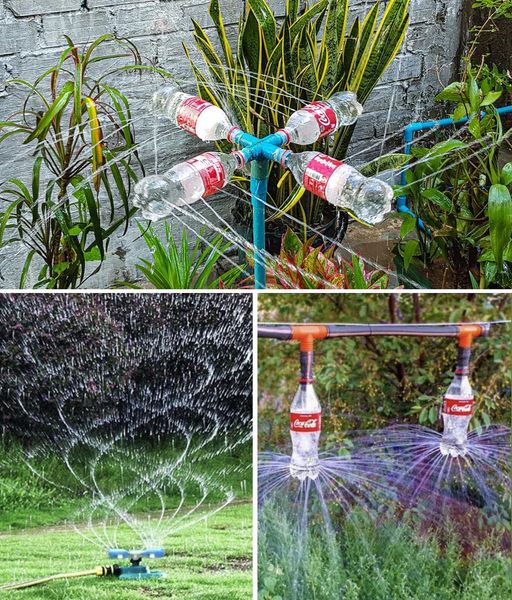Creating an efficient and eco-friendly rotating irrigation sprinkler just got an upgrade! By incorporating a mechanical bearing into the design, we enhance the rotation mechanism for smoother operation and better durability. This modification allows for a more reliable and effective irrigation system for your garden. Follow this updated step-by-step guide to build your own.

Updated Materials List:
- 2 plastic bottles (0.5-liter size)
- PVC ‘T’ connector (diameter slightly smaller than the mouth of your plastic bottles)
- 1 larger PVC pipe (to house the mechanical bearing)
- 1 smaller PVC pipe (to go through the bearing)
- Mechanical bearing (compatible with the diameter of the smaller PVC pipe)
- PVC glue
- Waterproof sealant or rubber seals
- Drill or sharp tool for making holes
Revised Steps:
1. Preparing the PVC ‘T’ Connector:
- Heat the PVC ‘T’ connector slightly so it becomes flexible. Carefully insert the plastic bottles into the ends, ensuring a tight fit. Avoid overheating to maintain the integrity of the PVC.
2. Modifying the Plastic Bottles:
- Drill or make a hole in the middle of each bottle, pointing upwards, for water to spray out.
- Create another hole at the bottom side of each bottle for the rotating mechanism. Ensure one bottle has the hole on one side and the other bottle on the opposite side for balanced rotation.
3. Constructing the Rotating Mechanism with a Mechanical Bearing:
- Select a larger PVC pipe that can snugly accommodate the mechanical bearing. Glue the bearing inside one end of this pipe using PVC glue. Make sure it’s centered to ensure smooth rotation.
- Slide the smaller PVC pipe through the mechanical bearing. This pipe acts as the axis of rotation and should move freely within the bearing.
- Seal both ends around the smaller pipe where it exits the larger pipe. Use waterproof sealant or rubber seals to prevent water leakage while allowing the pipe to rotate.
4. Assembly:
- Connect your garden hose to the bottom end of the smaller PVC pipe. This setup will serve as the vertical support and water supply line for your sprinkler.
- Attach the PVC ‘T’ with the bottles to the top end of the smaller PVC pipe. Ensure the assembly is secure and balanced for even rotation.
- The larger PVC pipe with the bearing should be fixed in place, while the smaller pipe with the attached bottles and ‘T’ connector rotates within it.

Finishing Touches:
Turn on the water and adjust the flow to test the sprinkler’s rotation. The water pressure from the holes in the bottles will cause the assembly to spin, providing an even distribution of water across your garden.
Tips for Success:
- Choose a bearing that can withstand water exposure to ensure longevity.
- Test the rotation before sealing everything to make adjustments as needed.
- Painting or treating the PVC parts can protect them from the elements and extend the lifespan of your sprinkler.
This upgraded rotating irrigation sprinkler design combines simplicity with efficiency, using a mechanical bearing for smoother operation. It’s a fantastic weekend project that yields a practical tool for garden watering, showcasing your DIY skills and commitment to sustainability.
